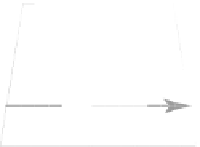Graphics Reference
In-Depth Information
From the above discussion, we understand that both the left and bottom edges of
rectangle
R
t
will be kept stationary under scaling. As a result, when we apply
S
(
3
,
0
.
5
)
on the vertices of rectangle, we get rectangle
R
ts
:
⎧
⎨
V
at s
=(
6
,
1
.
5
)
,
R
i
V
bt s
=(
0
,
1
.
5
)
,
R
o
Output from scaling :
⎩
V
ct s
=(
0
,
0
)
,
T(-1,-
5)
V
dts
=(
6
,
0
)
.
T(1,5)
When comparing to
R
t
,
R
ts
is the result of stretching the right edge by three times
and the compressing the top edge by half the original height. Notice that there is
no counterintuitive movement when scaling
R
t
into
R
ts
. Figure 9.6 shows that by
R
t
R
ts
applying the inverse of the original translation operator
Figure 9.6.
Achieving
the effect of Figure 8.9.
T
−
1
(
−
1
,−
5
)=
T
(
−
(
−
1
)
,−
(
−
5
)) =
T
(
1
,
5
)
to the vertices of rectangle
R
ts
,weget:
⎧
⎨
V
ao
=(
7
,
6
.
5
)
,
V
bo
=(
,
.
)
,
5
6
5
Vertices of
R
o
:
⎩
V
co
=(
5
,
5
)
,
V
do
=(
7
,
5
)
.
Transforming from rectangle
R
i
to
R
o
, we have accomplished the effects of Fig-
ure 8.9.
9.3.1
Scaling with Arbitrary Pivot
In the above example, we applied a series of three operators,
T
−
1
T
(
−
1
,−
5
)
S
(
3
,
0
.
5
)
(
−
1
,−
5
)
,
to the input vertices of the original rectangle
R
i
. Notice that the last operator
(
T
−
1
) is the inverse transform of the first translation operator (
T
). In practice, the
above three operators are used in the following way.
Order of operation.
Remem-
ber that the
leftmost
operator is
the one that operates on input
vertices
first
. In the case of
TST
−
1
1.
Translation.
Translates all vertices such that the center of scaling becomes
the origin. In the above example, the scaling operation was defined with
respect to the lower-left corner of rectangle
R
i
, and thus the translation is
,
t
x
=
−
T
will be the first to be applied
on the input.
5
,
displacement
=
t
y
=
−
1
.
This operation translates the lower-left corner to the origin.







































































































Search WWH ::

Custom Search